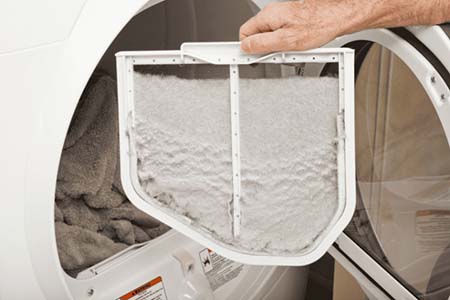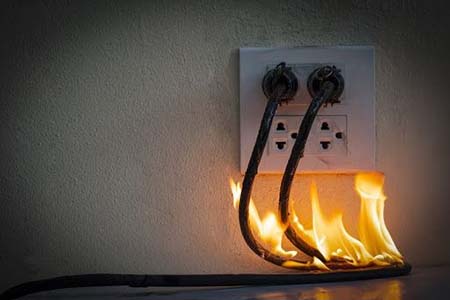Understanding the Concern
When dryer smells like burning it can manifest in various ways, ranging from a subtle, faint odor to a more pronounced, acrid scent. It might be a one-time occurrence or a recurring issue. Recognizing the specific characteristics of the smell and any accompanying symptoms, such as unusual noises or performance issues, can provide valuable clues about the root cause.
Importance of Addressing the Issue
Addressing a burning smell in your dryer is not just a matter of convenience; it’s a critical step in ensuring the safety of your home and the longevity of your appliance. There are several reasons why taking this concern seriously is paramount:
- Fire Hazard: A burning smell suggests that there may be a potential fire hazard within your dryer. Ignoring it can lead to disastrous consequences, including house fires.
- Appliance Health: The burning smell might be indicative of a malfunction or component damage within your dryer. Ignoring the issue could worsen the damage, leading to more extensive and costly repairs.
- Peace of Mind: Living with the worry of a potential dryer-related fire is stressful. Addressing the issue promptly will provide peace of mind, allowing you to use your appliance without fear.
- Energy Efficiency: A malfunctioning dryer is likely to be less energy-efficient. By resolving the problem, you can save on energy costs and reduce your carbon footprint.
- Clothing Care: Dryers that produce a burning smell can damage your clothes, leaving them with unpleasant odors or even scorch marks. Proper maintenance ensures your garments remain in excellent condition.
In the following sections, we will delve deeper into the potential causes of a burning smell in your dryer and guide you through the steps to identify and rectify the issue. Your vigilance and swift action will contribute to a safer and more efficient home environment.
Common Scenarios of a Dryer Smelling Like Burning

The presence of a burning odor in your dryer can manifest in several common scenarios, each offering valuable insights into the underlying problem:
- Burning Lint: One of the most frequent culprits is the accumulation of lint within the dryer. Over time, lint can accumulate in various parts of the machine, including the lint filter, exhaust duct, or even around the heating element. When lint ignites due to high temperatures, it can produce a noticeable burning smell.
- Overheating Components: A malfunctioning or overheating component within the dryer can also generate a burning odor. This can include issues with the heating element, thermostat, or other electrical components. Recognizing this scenario may require checking for unusual noises or performance issues in addition to the smell.
- Electrical Problems: Faulty wiring, damaged power cords, or electrical issues within the dryer can be another source of the burning smell. Electrical problems are a serious concern due to the risk of fire.
- Foreign Objects: Occasionally, small foreign objects like buttons, coins, or pieces of clothing labels can become trapped in the dryer’s components, leading to friction and heat generation. Identifying this scenario may involve inspecting the drum and other internal parts.
Safety Precautions
When faced with a burning smell from your dryer, it’s essential to prioritize safety:
- Ventilation: Ensure that the laundry room or area where the dryer is located is well-ventilated. This can help dissipate any fumes or odors.
- Power Off: Immediately turn off the dryer and unplug it from the power source. This step is crucial to prevent any potential hazards, especially if the source of the burning smell is electrical.
- Avoid Ignition Sources: Keep any flammable materials away from the dryer, and do not use the appliance until you have identified and resolved the issue.
- Vent Inspection: Check the dryer’s exhaust vent to ensure it is clear and unobstructed. A blocked vent can lead to overheating and the production of a burning smell.
When to Seek Professional Help
While some burning smell scenarios can be resolved with DIY solutions, there are instances where professional help is necessary:
- Persistent Odor: If the burning smell persists after cleaning and performing basic troubleshooting, it’s a sign of a more complex issue.
- Electrical Problems: Any suspicion of electrical problems should prompt immediate professional intervention due to the associated fire risk.
- Complex Repairs: If the problem involves significant component replacements or complex repairs, it’s advisable to consult a qualified appliance technician.
- Safety Concerns: If you are unsure about the safety of using your dryer, err on the side of caution and seek professional help.
In the following sections, we will delve into potential causes and DIY solutions for addressing the burning smell in your dryer. Identifying the root cause is essential before attempting any repairs or maintenance.
Potential Causes of the Burning Smell
Lint Buildup and Clog

Lint buildup and clogging within your dryer are among the most common and potentially hazardous causes of a burning smell. Lint, which is composed of fine fibers from your laundry, can accumulate in various areas of the dryer, including:
- Lint Filter: The lint filter, also known as the lint trap, is the first line of defense against lint buildup. However, it can become clogged over time if not cleaned regularly.
- Exhaust Duct: Lint can make its way into the exhaust duct that leads to the outside of your home. A clogged exhaust duct restricts airflow, leading to overheating and, ultimately, a burning odor.
- Around Heating Elements: In some cases, lint can accumulate around the heating element or burner assembly, which generates heat to dry your clothes. When lint ignites due to high temperatures, it produces a burning smell.
Addressing Lint Buildup and Clogs:
- Regular Cleaning: The best preventive measure is regular cleaning. Ensure you clean the lint filter before or after every load of laundry. Additionally, periodically vacuum the lint filter area to remove any lingering lint.
- Exhaust Duct Inspection: Check the exhaust duct for any blockages or clogs. If you notice significant lint buildup, it’s essential to clean it thoroughly. In some cases, it may require professional cleaning, especially if the duct is hard to access.
- Heating Element Cleaning: If you suspect lint buildup around the heating element, it’s crucial to disconnect the dryer from the power source and remove the back panel (if possible) to access and clean this area. Exercise caution and consider professional assistance if needed.
Overheating Components
Overheating components within the dryer can also lead to a burning odor. Common components that may overheat include:
- Heating Element: The heating element or burner assembly is responsible for generating heat to dry your clothes. If it malfunctions or overheats, it can produce a burning smell.
- Thermostat: The thermostat regulates the temperature inside the dryer. A faulty thermostat can lead to overheating.
- Wiring and Connections: Damaged or loose wiring and connections can result in electrical resistance and heat generation.
Addressing Overheating Components:
- Professional Inspection: If you suspect overheating components, it’s advisable to seek professional appliance repair services. Technicians can diagnose and repair or replace the faulty parts safely.
Electrical Issues

Electrical issues within the dryer can pose a significant fire hazard and result in a burning smell. Common electrical problems include:
- Faulty Power Cord: A damaged or frayed power cord can lead to arcing and overheating.
- Faulty Outlets: An electrical outlet that is not functioning correctly can cause problems.
- Internal Wiring Issues: Wiring within the dryer can become damaged or loose over time, leading to electrical problems.
Addressing Electrical Issues:
- Professional Help: Electrical problems should always be addressed by a qualified electrician or appliance repair technician to ensure safety.
Foreign Objects in the Dryer
Foreign objects, such as buttons, coins, or small clothing labels, can inadvertently find their way into the dryer’s drum or other components. When these objects create friction against the drum or other parts, they can generate heat and produce a burning odor.
Addressing Foreign Objects:
- Inspect and Remove: Carefully inspect the drum and other internal parts of the dryer. If you discover foreign objects, remove them to eliminate the source of friction and heat.
In the following sections, we will provide guidance on specific DIY solutions and maintenance steps to address these potential causes of a burning smell in your dryer.
DIY Solutions and Maintenance
Cleaning and Removing Lint Buildup
Proper maintenance is the cornerstone of preventing a burning smell in your dryer. Regular cleaning to remove lint buildup not only eliminates a common cause of overheating but also extends your dryer’s lifespan.
- Lint Filter Cleaning: Clean the lint filter before or after each load of laundry. Use a soft brush or vacuum cleaner attachment to remove lint that may be stuck in the filter screen. Rinse the filter with water periodically to remove any residue buildup.
- Exhaust Duct Inspection: Check the exhaust duct for any signs of lint buildup or clogs. Disconnect the duct from both the dryer and the exterior vent and use a vent brush or vacuum attachment to clean it thoroughly. Ensure that the exterior vent cover is free from obstructions.
- Internal Cleaning: Periodically, it’s a good idea to remove the back panel of the dryer (if possible) and inspect the area around the heating element and the blower wheel for lint accumulation. Use a vacuum cleaner with a nozzle attachment to clean these areas.
Checking and Replacing Overheating Components
Identifying and addressing overheating components is crucial for safe and efficient dryer operation. Here’s how to go about it:
- Heating Element: If you suspect the heating element is malfunctioning or overheating, it’s best to consult a professional technician for diagnosis and replacement. Attempting to replace the heating element yourself can be complex and potentially hazardous.
- Thermostat: A faulty thermostat can lead to overheating. You can check the thermostat for continuity using a multimeter. If it’s malfunctioning, it should be replaced by a qualified technician.
- Wiring and Connections: Examine the dryer’s wiring and connections for any visible damage, loose connections, or signs of burning. If you find issues, it’s best to call a professional to address the wiring problem safely.
Electrical Troubleshooting
If you suspect electrical issues, it’s crucial to approach them with caution and safety in mind:
- Power Cord Inspection: Check the power cord for any visible damage, fraying, or exposed wires. If you notice issues, do not use the dryer until the power cord is replaced by a qualified electrician.
- Outlet Testing: Test the electrical outlet with another device to ensure it’s functioning correctly. If the outlet is faulty, consult an electrician to rectify the problem.
- Internal Wiring: If you suspect internal wiring issues, it’s essential to hire a qualified appliance repair technician. Attempting to address internal wiring problems without the necessary expertise can be dangerous.
Inspecting and Removing Foreign Objects
Inspecting your dryer for foreign objects is a straightforward but essential task:
- Drum Inspection: Check the drum for any foreign objects, such as buttons, coins, or small clothing labels. Remove any items you find to prevent further friction and heat generation.
By following these DIY solutions and maintenance steps, you can often resolve the burning smell issue in your dryer and ensure safe and efficient operation. However, if you are unsure about any aspect of troubleshooting or if the problem persists, it’s always wise to consult a professional technician for a thorough diagnosis and repair. Your safety and the longevity of your appliance are of utmost importance.
Regular Dryer Maintenance
Proper maintenance is your best defense against future burning smells in your dryer. Regular maintenance routines help keep your appliance in top condition and prevent common issues that can lead to odors. Here are some essential maintenance tasks to consider:
- Lint Filter Cleaning: Clean the lint filter before or after each laundry cycle. Removing lint from the filter ensures proper airflow and reduces the risk of lint igniting within the dryer.
- Exhaust Duct Cleaning: Periodically inspect and clean the exhaust duct. Disconnect it from both the dryer and the exterior vent, and use a vent brush or vacuum attachment to remove any lint buildup or obstructions. Ensure that the exterior vent cover is free from debris.
- Internal Inspection: Occasionally, remove the back panel of the dryer (if possible) to access and inspect internal components. Check for any signs of lint accumulation or foreign objects. Use a vacuum cleaner with a nozzle attachment to clean these areas.
- Thermostat and Sensor Checks: If your dryer has temperature control sensors or thermostats, test their accuracy regularly. Consult your dryer’s user manual for specific instructions on how to perform these checks.
- Proper Installation: Ensure your dryer is correctly installed and properly vented. Incorrect installation or venting can lead to overheating and burning smells. Consult the manufacturer’s guidelines or consider professional installation if needed.
Best Practices for Safe Usage
Using your dryer safely is crucial for preventing overheating and other issues that can lead to burning smells. Follow these best practices for safe dryer usage:
- Don’t Overload: Avoid overloading the dryer, as it can restrict airflow and lead to overheating. Follow the manufacturer’s recommended load capacity.
- Use the Right Settings: Select the appropriate heat settings for your laundry. Delicate fabrics should be dried on lower heat settings, while heavier items may require higher temperatures.
- Clean the Entire Lint Path: In addition to cleaning the lint filter, periodically clean the entire lint path, including the exhaust duct and any internal components where lint can accumulate.
- Regularly Inspect Clothing: Before placing clothes in the dryer, check pockets for items like coins, buttons, or small objects that can cause friction and heat generation.
- Ventilation: Ensure proper ventilation in the laundry area. Adequate airflow helps dissipate heat and odors, reducing the risk of burning smells.
- Supervise While in Use: Whenever possible, supervise the dryer while it’s in operation. If you notice any unusual odors or sounds, stop the dryer immediately and investigate.
By incorporating these maintenance routines and best practices for safe dryer usage into your laundry routine, you can significantly reduce the risk of future burning smells. A well-maintained and properly used dryer not only operates efficiently but also enhances safety and prolongs the life of your appliance.